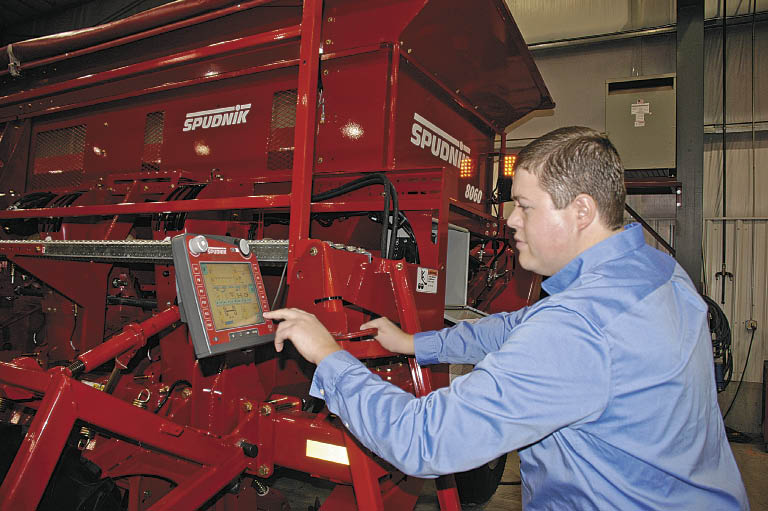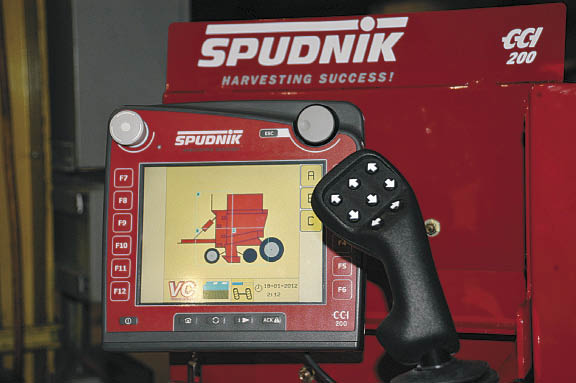 Planting and harvesting are the essential bookends to a successful season. While GPS technology has been vital to streamlining these tasks, Spudnik has come up with a new and improved panel to make controlling the planter-and harvester-easier.
Planting and harvesting are the essential bookends to a successful season. While GPS technology has been vital to streamlining these tasks, Spudnik has come up with a new and improved panel to make controlling the planter-and harvester-easier.
Spudnik introduces the Spudnik CCI 200 Touch Screen. With it, growers get more capability, visibility and flexibility with their equipment.
The Spudnik CCI 200 Touch Screen comes with an operator-friendly, multi-function joystick, start-of-row and end-of-row function, is farm-equipment friendly, has ISOBUS capability and has the quickest machine diagnostics in the industry.
Intuitive Control
Keith Mecham, Spudnik electrical engineer, says the company wanted to improve on the older control panel by taking some of the burden off the operator-automating common tasks, especially those that are safety-related.
"We won't take control away from the operator, but we want to help him out and give him less to worry about for every moment he's in the cab. We don't want him to think, `Don't touch anything or else it's going to stop working.' We want it to be more cooperative and more comfortable."
With this new touch-screen display, operators have the ability to put any function on any button they want and won't need IT degrees to figure it out.
"The controls are pretty intuitive and a lot more useful than our older generation," he says.
Mecham says if the harvester hits a rock, the digger nose is going to float up out of the way, but then automatically return to the set point. When the harvester is on a side hill, machine leveling can be controlled through the panel. The boom can be hydraulically controlled as well, but it's up to the operator what he wants running manually and what he wants running automatically.
"Anything they want to do, they can configure however they'd like it," he says.

Monitoring Accuracy
The Spudnik CCI 200 Touch Screen monitors planter performance of each row individually and visually alarms the operator of skips.
Short-term accuracy is shown in a bar graph form to show immediate changes. If it skips 3 percent of the time, accuracy will show 97 percent accuracy. The more skips, the faster the bar drops. Long-term accuracy is displayed numerically and helps the operator see trends in how well each row is being planted.
"When you start up in the morning, it gets to 100 seed pieces and then starts averaging. Once it hits 10,000, the oldest samples fall off. You're continually looking at 30-40 minutes of time."
According to Mecham, it's up to the operator to determine at what accuracy level the alarm will go off.
This year, Spudnik engineers found they were able to encourage growers to adjust their row units now that there was a long-term accuracy number to go by.
"If you have a row that's out of adjustment, it becomes very obvious because you'll have 92, 93, 96 and then all of a sudden you'll have one row that's 78. You'll know something is way out of adjustment. The proper thing to do is stop and figure out, `Is my shaker too aggressive? Is my feed bowl too empty? Do I need more seed? Do I have a rock that's keeping seed from filling the cups?' When guys can see that trend, it really helps them do a better job."
The control panel defaults to a six-row planter, but growers can have them on eight- or 10-row planters.
The older-generation control panel would only work on the planters; however, with the Spudnik CCI 200 Touch Screen, operators can simply hook it along with the accompanying joystick to a Spudnik harvester, without needing to reprogram the display. Settings are stored on the implement's controller-not the display-for both implements. "The two machines store their own information, and the control panel is your window to see into it."
Mecham says growers don't need to buy a new control panel for every Spudnik machine, just for every harvester/planter pair.
The control panel operates on the ISOBUS communication protocol, more consistently used in Europe than North America. The machine is primarily symbol-based rather than text-based.
 No More Eyeballing
No More Eyeballing
Bart Wattenbarger of Wattenbarger Farms in Shelley, Idaho, was introduced to this technology by a field man for Spudnik. For years, Wattenbarger has relied on someone on the planter as well as in the tractor eyeballing everything. The Spudnik CCI 200 Touch Screen changed that.
"This allowed us to take the person off the planter and use the electronic eyes in the computer to do the same thing. If we needed to make adjustments, we could see that at all times-each individual shoe inside the cab-and make adjustments and get it to plant more accurately.
They were really impressed with how it worked for them this past season.
"The accuracy was quite high. Every time we dug behind the machine, it was very similar to what the monitor was telling us," he says.
The technology is simple to use.
"I like the fact that each planter uses the same thing. You're not relying on a person in the back on one planter and the person on the other using something different. We can synchronize our planters better by using this kind of technology and get the accuracy on both of them more equal."
Richard Bishop, control engineering manager for Spudnik, pointed out that Wattenbarger-a smartphone user-caught on quickly, but so did another grower who wasn't a smartphone user.
"He realized pretty quickly that he had to push one button for down and one button for up, and it would do everything-his fertilizer, everything. I think he was more concerned that it wasn't going to automatically do its thing. It took four or five steps away from him that he was used to doing."
The Spudnik CCI 200 Touch Screen is standard on all planters with Professional Controls this year. Last season, only a handful of the older control panels were sold, and only if special-ordered.
"The cost for the whole system is a couple hundred dollars difference to retire this old technology and give you something a lot better," Mecham says.